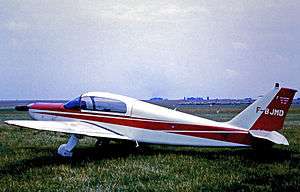Scintex Rubis
The Scintex ML 250 Rubis was a French civil utility aircraft of the 1960s.
| Scintex Rubis | |
|---|---|
 | |
| Scintex Rubis at Guyancourt airfield, Paris, in 1965 | |
| Role | General aviation aircraft |
| National origin | France |
| Manufacturer | Scintex-Aviation |
| First flight | 3 June 1962 |
| Introduction | 1964 |
| Primary user | Private owners |
| Number built | 8 |
| Developed from | ML 145 |
Design and development
Scintex Aviation had manufactured the two-seat Emeraude from the late 1950s. In 1960 the firm designed the ML 145 four-seat low-wing cabin monoplane, powered by a 145 h.p. Continental O-300-B engine, the single example of which first flew on 25 May 1961.[1]

Scintex developed the ML 250 with a larger five-seat cabin and fitted with a 250 hp (186 kW) Lycoming O-540 engine. This first flew on 3 June 1962.[2] The aircraft was of a graceful design, using an all-wood construction, having a semi-monocoque plywood-covered fuselage and cantilever tapered low wing. The tail fin was swept and the aircraft, unusually, was fitted with a fully retractable tailwheel undercarriage.
Production and service
Eight production examples of the ML 250 Rubis were completed by Scintex during 1964-1965. Whilst the type had an advanced specification, it suffered from competition from contemporary all-metal aircraft types such as the Piper Comanche. The Rubis has remained in service with French private pilots and four were airworthy in 2005.[3] Two of these, including the aircraft pictured right (F-BJMD) were still active on the French civil aircraft register in 2015.[4].
Specifications
Data from Jane's All The World's Aircraft 1965–66[5]
General characteristics
- Crew: 1
- Capacity: 3–4 passengers
- Length: 7.75 m (25 ft 5 in)
- Wingspan: 10.25 m (33 ft 8 in)
- Height: 1.90 m (6 ft 3 in)
- Wing area: 14.78 m2 (159.1 sq ft)
- Aspect ratio: 7:1
- Airfoil: root: NACA 23015 tip: NACA 23009
- Empty weight: 800 kg (1,764 lb)
- Fuel capacity: 52 L (14 US gal; 11 imp gal)
- Powerplant: 1 × Lycoming O-540-A1D5 air-cooled flat-six engine, 190 kW (250 hp)
Performance
- Maximum speed: 315 km/h (196 mph, 170 kn) at sea level
- Cruise speed: 270 km/h (170 mph, 150 kn) (econ cruise)
- Stall speed: 98 km/h (61 mph, 53 kn)
- Never exceed speed: 348 km/h (216 mph, 188 kn)
- Range: 1,550 km (960 mi, 840 nmi) at 270 km/h (170 mph; 150 kn)
- Service ceiling: 6,500 m (21,300 ft)
- Rate of climb: 6.48 m/s (1,275 ft/min)
- Takeoff distance to 15 m (50 ft): 255 m (837 ft)
- Landing distance from 15 m (50 ft): 345 m (1,132 ft)
References
| Wikimedia Commons has media related to Scintex Rubis. |
- Notes
- Green 1965, p. 63
- Simpson 2001, pp. 489–490
- Simpson 2001, p. 489
- Partington 2015, p. 216
- Taylor 1965, p. 55
- Bibliography
- Green, William (1965). The Aircraft of the World. Macdonald & Co. (Publishers) Ltd.CS1 maint: ref=harv (link)
- Simpson, Rod (2001). Airlife's World Aircraft. Airlife Publishing Ltd. ISBN 1-84037-115-3.CS1 maint: ref=harv (link)
- Taylor, John W. R. (1965). Jane's All The World's Aircraft 1965–66. London: Sampson Low, Marson & Co., Ltd.CS1 maint: ref=harv (link)
- Partington, David (2015). European Registers Handbook 2015. Tonbridge: Air-Britain (Historians) Limited. ISBN 978-0-85130-475-5.CS1 maint: ref=harv (link)